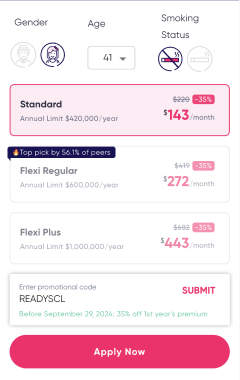Considering to purchase savings insurance? First consider your goals. If you are looking for steady stream of income and partial protection, savings insurance may be good for you.
What is savings insurance? Who should buy it?
Savings insurance is insurance with a cash value savings component. Generally it has little or even no life protection component.
Since people purchased savings insurance do so mostly to build wealth or save for life goals such as retirement, the savings insurance policies which emphasize life protection are not discussed in this article.
Purchasing savings insurance means entrusting the work of wealth accumulation to the insurance company. Then, you don’t have to monitor the investment markets or read financial statements, as long as your assets are growing over time. In addition, the cash value of an insurance policy does not fluctuate like stocks (of course, the potential returns may not be on par with holding stocks for the long term), which is highly suitable for those who are unwilling to take risks or are too caught up with work to manage their assets.
Certainly, regardless of your choice for investment, the sooner you start investing, the more interest you can earn on your money, and cash value insurance is no exception. Investors should choose products that suit them according to their risk tolerance and expected returns.
Policy duration and payment period
Generally, the payment period can last from a minimum of 5 years to a maximum of 20 years or more (on occasion, certain plans have a payment period as short as 2 years or can be paid in a lump-sum payment, but in such cases, the minimum amount of payment is usually higher). The payment period can be long or short, depending on the savings goals; generally, the shortest is 5 years, and the longest can span a lifetime.
What will happen if you stop making payments?
The policyholder of a savings insurance policy generally cannot stop making payments during the payment period, and the suspension of payments may seriously affect the returns.
Depending on whether the accumulated cash value is sufficient to keep the policy in force, in the worst case scenario the policy may lapse, and the cash surrender value may be significantly less than the total payment amount.
Therefore, before purchasing a policy, you should clearly understand your financial goals and choose the appropriate policy according to your financial circumstances and cash flow. If necessary, you can consult a qualified and experienced financial planner.
Guaranteed cash value and non-guaranteed benefits differences
Before an insurance company launches a product, it usually sets up a reserve with a sum of money, which is called a pool in the industry, and then invests this money to obtain some returns. Most insurers buy long-term government bonds and may sometimes also invest in high-yield blue-chip stocks or in real estate to receive rental income.
Rather than short-term capital gains, insurance companies tend to value long-term investment incomes, such as:
- Bond interest
- Stock dividends
- Rental income.
Therefore, when a product is being launched, a portion of the returns has already been guaranteed. Therefore, an insurance company can provide a guaranteed return, which is generally referred to as a policy’s cash value.
There are certain uncontrollable risk factors in investment, such as:
- The rise and fall of stock prices
- Whether the payout of stock dividends is stable, etc.
Some factors that affect non-guaranteed benefits for participating policies include:
- The insurer’s profits
- Claims settlement experience, etc.
Professional actuaries at an insurance company create an estimate or forecast of future situations based on past experience, data, and certain assumptions. Based on such assumptions, they can determine the non-guaranteed benefits.
These non-guaranteed benefits can usually be withdrawn by customers at any time (here referring to American-style policies, not British-style policies with reversionary bonuses). If the customer does not need to use the money in the meantime and chooses to keep it in the policy, the insurance company will distribute additional non-guaranteed interest. Generally, the annual interest rate would be higher than the bank deposit interest rate. At the time of writing, the common U.S. dollar policy dividend rollover rate is 4% per annum. Of course, an insurance company can adjust the interest rate at any time according to its own financial position and the market interest rates.
Would insurers overstate non-guaranteed benefits?
To prevent insurance companies from making high projections of non-guaranteed benefits in order to attract customers, Insurance Authority stipulates that beginning January 1, 2017, insurers must regularly publish their fulfillment ratio of non-guaranteed benefits so that consumers can judge whether the insurer’s assumptions are reasonable and credible based on the insurer’s past performance.
Thus, you should be wary if you see that an insurer’s fulfillment ratio fluctuates a lot or is often below 100% as it means that the insurer’s assumptions may be too far off.
No doubt, insurers of good repute make reasonable assumptions and strive to achieve their projected non-guaranteed benefits. By doing so, they earn their customers’ trust in the long term. In fact, many insurance companies do continue to provide fulfillment ratios that are close to or even higher than 100%.
How one allocates one’s assets varies from person to person. If necessary, you should consult a professional financial planner.
Should you buy savings insurance when the investment market is not doing well?
This is not a question that can be easily answered. Poor market conditions usually indicate that stock prices have fallen a lot. For those long-term investors, it may be the perfect opportunity to purchase high-quality assets.
Just Like Warren Buffett says, “Be fearful when others are greedy and greedy when others are fearful”
Worth to note, we should not be lead by the short-term investment market. Especially when the atmosphere is pessimistic (or in other way around – very optimistic) as under such environment, sound judgement could hardly be made.
Wealth management is a long term mission. Whatever decisions we made, we should consider the factors in medium to long term. Thus, we should consider the asset allocation in order to match our financial goals. Aggressive investors can take high risk in exchange for high potential returns; conservative investors should deploy more low-volatility instruments.
It is never a bad thing to put a part of their assets in a tool (like savings insurance) for steady growth. After all, rarely can a person bear a drastic drop in the stock price while keeping calm, and even shout “Be greedy when others are fearful”.
Of course, asset allocation varies from person to person. We strongly recommend to consult a professional financial planner if necessary.







